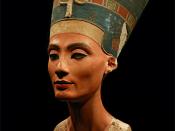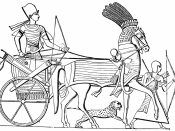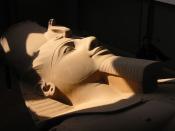Art was very important to the Egyptian culture. Ancient Egypt lasted from about 3000 B.C. to about 1000 B.C. Art symbolized Egyptian beliefs and every day life. Today in western culture, we generally consider art a form of self-expression. However, for the Egyptians it was almost religious. The Egyptians took art very seriously and strictly followed very specific rules, though over time as Egypt grew, so grew the standards and styles of the arts. Egyptians believed that imperfect art (art that did not adhere to the strict rules) upset the gods.
Egyptian art emphasized three basic elements, engraving, sculpture, and painting. Engravings lined the inside of tombs and are the most common and well-known form of Ancient Egyptian art. The engravings depicted the pharaoh's life, the gods, and legends about them. Paintings, another common art form, usually depicted legends about the gods with hieroglyphic captions explaining them. The last common form of Egyptian art was sculpture.
Sculptures usually honored pharaohs and gods. However, archaeologists have also discovered sculptures of animals. Many of these animal sculptures were cats, which Egyptians believed were sacred.
The Egyptians strictly upheld the style of frontalism, adhering carefully to stylistic rules. First, the subject's head is always drawn in profile with the full eye shown. The upper body, however, is depicted from the front and the legs face in the same direction as the head with one foot in front of the other. The person in the picture sits or stands stiff and rigid in a formal posture, but the face is calm and usually slightly tilted toward the sky. In addition, nothing can obstruct the pharaoh's face or body. Less important figures were drawn less formally in positions that are more natural. For example, slaves were drawn more relaxed and realistic, while a pharaoh...


